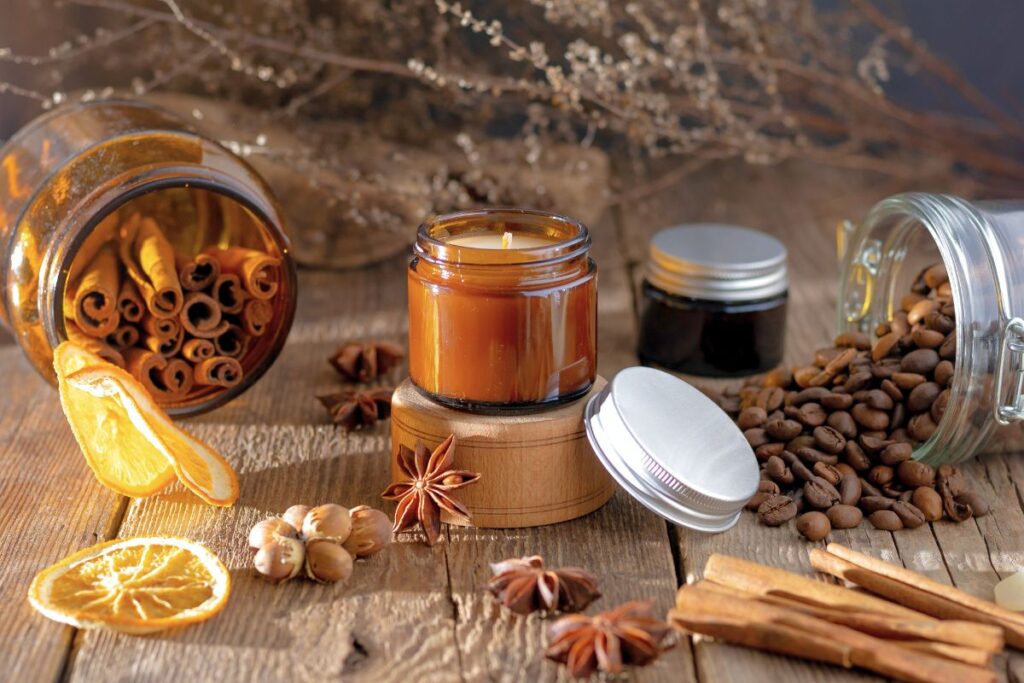In a single breath, scented candles transport you to beautiful places or moments. Inhale the tropical scents of hibiscus or jasmine, and you find yourself on a lush island paradise. Breathe in the warm, woody notes of cedarwood and vanilla, and suddenly you’re nestled in a cozy cabin by a crackling fire.
These delightful scents create a soothing atmosphere, but a question arises: are they truly harmless? Understanding the composition of a scented candle – whether it uses synthetic fragrances or essential oils – and its impact on indoor air quality is key. With this knowledge, we can make informed choices, ensuring our scented journeys enhance our mood and well-being without compromise.
Let’s Clear The Air!
Choosing scented candles involves navigating a world of fragrance options. Candle scents originate from three main sources:
- 100% pure essential oils
- Natural fragrances
- Synthetic fragrances
*This can be confusing, as even “natural fragrances” aren’t always entirely natural.
100% Pure Essential Oil:
Essential oils extracted directly from plants are 100% pure. This candle offers the purest form of natural fragrance, offering a natural aroma with potential therapeutic benefits.
Natural Fragrance:
In this category, essential oils, plant extracts, resin, and sometimes synthetic components are blended together to produce a variety of scents. While not strictly natural, this approach offers a broader range of scent profiles, increased complexity, and may be less expensive than solely using essential oils.
Synthetic Fragrance: With a wide range of scent options at an affordable price, scents in these candles is crafted from lab-created molecules. Because of their use of potentially harmful chemicals, they raise concerns about allergens or environmental impact. These molecules may mimic natural fragrances, but they do not provide the therapeutic benefits of plant-derived extracts.
To avoid confusion,
Here’s the key difference: Candles are scented by adding either essential oils, which are pure plant extracts; natural fragrances, which might contain essential oils but can also have synthetic ingredients; or synthetic fragrances, which are entirely lab-made.
What Are the Ingredients in Scented Candle?
It is not uncommon for scented candles to combine both synthetic and natural components in order to create the desired scent.
What is the reason for adding other ingredients? Fragrance creators formulate intricate and unique scents by blending various components that may not be possible with just essential oils alone.
Ingredients and Their Roles:
- Solvents: Blend fragrance components evenly throughout the candle for a uniform scent.
- Fixatives: Enhance the fragrance’s longevity and intensity as it diffuses into the air, making the candle last longer.
- Resins (Natural): Plant secretions like myrrh and frankincense give fragrances depth and complexity.
- Absolutes (Natural): Waxy plant extracts, like rose and jasmine absolutes, provide higher potency and a more natural scent than essential oils alone.
- Carrier Oils (Natural): Since essential oils are often too concentrated to be used directly in candles, carrier oils, such as soybean or coconut oil, dilute them for safe and even blending with candle wax.
Synthetic Ingredients
- Phthalates: Chemicals used to enhance the longevity and intensity of synthetic fragrances.Phthalates are linked to hormonal disruptions and respiratory problems.
- Parabens: Preservatives in fragrances that stop bacteria from growing.Some studies have linked parabens to certain cancers, but more research is needed.
- Formaldehyde: A carcinogen used in synthetic fragrance oils to preserve them.
- Benzene: A chemical released when burning paraffin wax candles. Benzene is a known carcinogen that causes many health problems.
- Synthetic Fragrance Oils: Usually this term contains undisclosed chemicals, some of which are harmful. Choose candles with natural essential oils or fragrance blends that disclose their ingredients.
Optional ingredients in all types that could be either natural or synthetic:
- Dye: Synthetic or natural pigments (color).
- Additives: UV stabilizers, antioxidants, fragrance boosters (improve performance and shelf life)
Synthetic Fragrance Oils: Made In Labs

In comparison with natural alternatives, synthetic scented candles offer a vast and enticing selection of fragrances, with impressive strength and longevity compared to natural alternatives. However, these benefits are not without their drawbacks.
First, synthetic candles often rely on paraffin wax, which is derived from petroleum. Benzene, toluene, and volatile organic compounds are released when paraffin wax is produced and burned, which causes poor indoor air quality and respiratory problems. A particular concern is benzene, a carcinogen, and the widespread use of paraffin wax in synthetic candles, which raises both health and environmental concerns.
Second, synthetic fragrance oils may contain petroleum-derived molecules even though they provide long-lasting scents. Inhaling these chemicals can cause various health concerns as lab-made molecules release irritants that compromise indoor air quality.
These irritants may include:
- Parabens: Disrupt hormone function
- Phthalates (used as fixatives): May interfere with reproduction
- Benzene derivatives: Irritate the respiratory system
- Formaldehyde: May cause respiratory problems
*** In general, synthetic fragranced candles contain a low percentage of essential oils or natural fragrances, which is why they are typically inexpensive.
100 % Essential Oil Candles: The Essence Of Nature

Infusing candles with pure essential oils is a fantastic way to produce exquisite scents. Beyond their pleasant aromas, these natural oil-based candles also possess therapeutic properties. For instance, lavender essential oil has a calming aroma, whereas peppermint oil is energizing. The natural fragrance they release positively impact indoor air quality making them a healthy and eco-friendly alternative to synthetically fragranced candles.
“The beauty of essential oils lies in preserving the true essence, spirit and
aroma of the plant itself.”
Aromatherapy uses essential oils for enhancing mood, reducing stress, alleviating headaches, easing muscle pain, and so much more. Cosmetics and skincare products also contain essential oils due to their hydrating, nourishing, and protecting properties. It only makes sense that they can also be used for candles!

The Purity Advantage
The purity advantage of natural scent candles lies both in their authenticity and the aromatherapy benefits they may provide over lab-made synthetic scents.
For instance,
- Lemon essential oil neutralizes odors, aids digestion, and possesses antibacterial properties.
- Grapefruit oil promotes mental clarity and concentration.
- Eucalyptus essential oil provides respiratory support and alleviates congestion.
Similarly, candles made with natural waxes, such as soy or beeswax, offer a cleaner burn and fewer toxins released into the air than those made with synthetic waxes like paraffin.
Let’s take beeswax as an example
- Aroma: A beeswax candle will emit a subtle, honey-like aroma while burning cleanly, whereas a paraffin candle may release potentially harmful substances like benzene and toluene into the air.
- Longer Burn Time: Natural waxes typically have a denser structure and higher melting point than paraffin. This translates to a longer burn time for your candle, allowing you to enjoy the fragrance for an extended period of time.
- Cleaner Burning: Natural waxes burn cleaner than paraffin wax, producing less soot and smoke. As a result, fewer pollutants are released into the air and black residue on walls and furniture is minimized.

Choosing Wisely!
Here’s how to identify candles with each fragrance type:
Some candle manufacturers claim their products contain “pure essential oils,” but the term “pure” does not always guarantee purity. Candles with 100% pure essential oils, Natural fragrances, and Synthetic fragrances can be identified as follows:
For candles made with 100% pure essential oils:
1. The labels proclaim “100% pure essential oils” as the fragrance source.
2. Aromatherapy claims: Aromatherapy or therapeutic candles often use pure essential oils.
3. Complexity of scent: Pure essential oil candles have more subtle and nuanced scents.
4. Price: 100% pure essential oils candles may cost more because of the extraction process.
For candles with natural fragrances:
1. Ingredient list: Labels with “natural fragrances” or specific natural sources of fragrance, such as plant extracts or absolutes.
2. Certifications: Some candles show they contain natural fragrances, such as “100% natural” or “organic.”
3. Scent complexity: Natural scents have more fragrant molecules than synthetics, giving them a richer, more interesting smell.
4. Price: Natural fragrance candles cost more than those made with synthetic fragrances because they usually blend essential oils with other natural ingredients or even synthetics.
For candles with synthetic fragrances:
1. Ingredient list: These can include terms such as “fragrance oil,” “synthetic fragrance,” or specific synthetic aroma chemicals.
2. Scent intensity: Synthetic fragrance candles tend to have stronger, longer-lasting scents than natural ones.
3. Price: Due to the lower production costs of synthetic fragrances, they are often more affordable.
4. Synthetic fragrances: provide more variety and diverse scents than natural ones.

Indoor Air Quality Matters
As mentioned previously, candles containing low-grade waxes and synthetic oils can pollute indoor air. Individuals with asthma or sensitivities to chemical fragrances may experience reactions to this. Additional details regarding synthetic fragrances, paraffin waxes, lead core wick candles, and fragrant incense can be found here.
Keeping Our Planet Clean
Whenever possible, we should avoid fossil fuel-burning industries. The production of paraffin wax (in mostly synthetic candles) contributes to greenhouse gas emissions since it is derived from petroleum, a non-renewable fossil fuel. The use of natural wax candles is healthier than the use of petroleum candles, so why not use them instead? Every eco-friendly act is like a ripple in a pond, spreading awareness and creating a larger impact.
The Balancing Act
In regards to selecting between synthetic and pure oil scents in candles, note that we are constantly exposed to VOCs from everyday sources. These include cleaning supplies, building materials, furnishings, office equipment, car exhaust and more. Complete elimination of toxins from our environment may not be feasible. Therefore, the key lies in understanding how much exposure one can handle without negative health effects.
Candles made with pure quality essential oils offer peace of mind and reduce overall VOC intake, especially for those sensitive to synthetic scents. Besides having a pure aroma connected to the essence of the plant that produces them, pure essential oils candles are therapeutic as well.
Personal preference and health concerns ultimately determine your choice. You can enjoy candlelit experiences guilt-free by searching for brands that are committed to transparency and that use high-quality, naturally derived essential oils. This will benefit your well-being as well as the environment. Lastly, choosing handcrafted candles made with care by artisans not only illuminates your space but infuses it with their dedication and positive energy.
Point Of Alignment
Understanding these ingredients empowers you to make informed choices. Whether you seek the purity of essential oils, the variety of natural fragrances, or the affordability and intensity of synthetics, you can now pick a candle that perfectly complements your mood and lifestyle.





